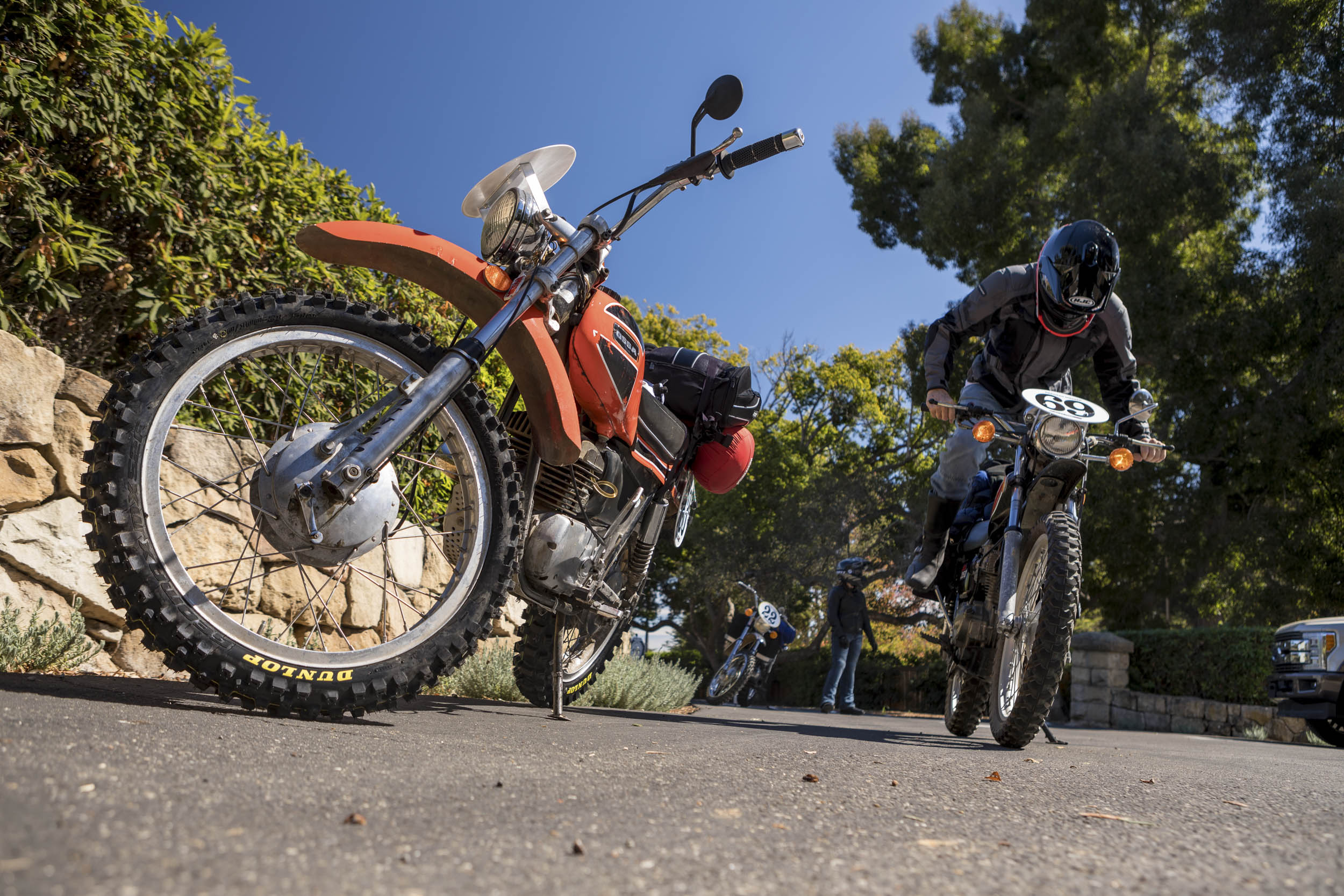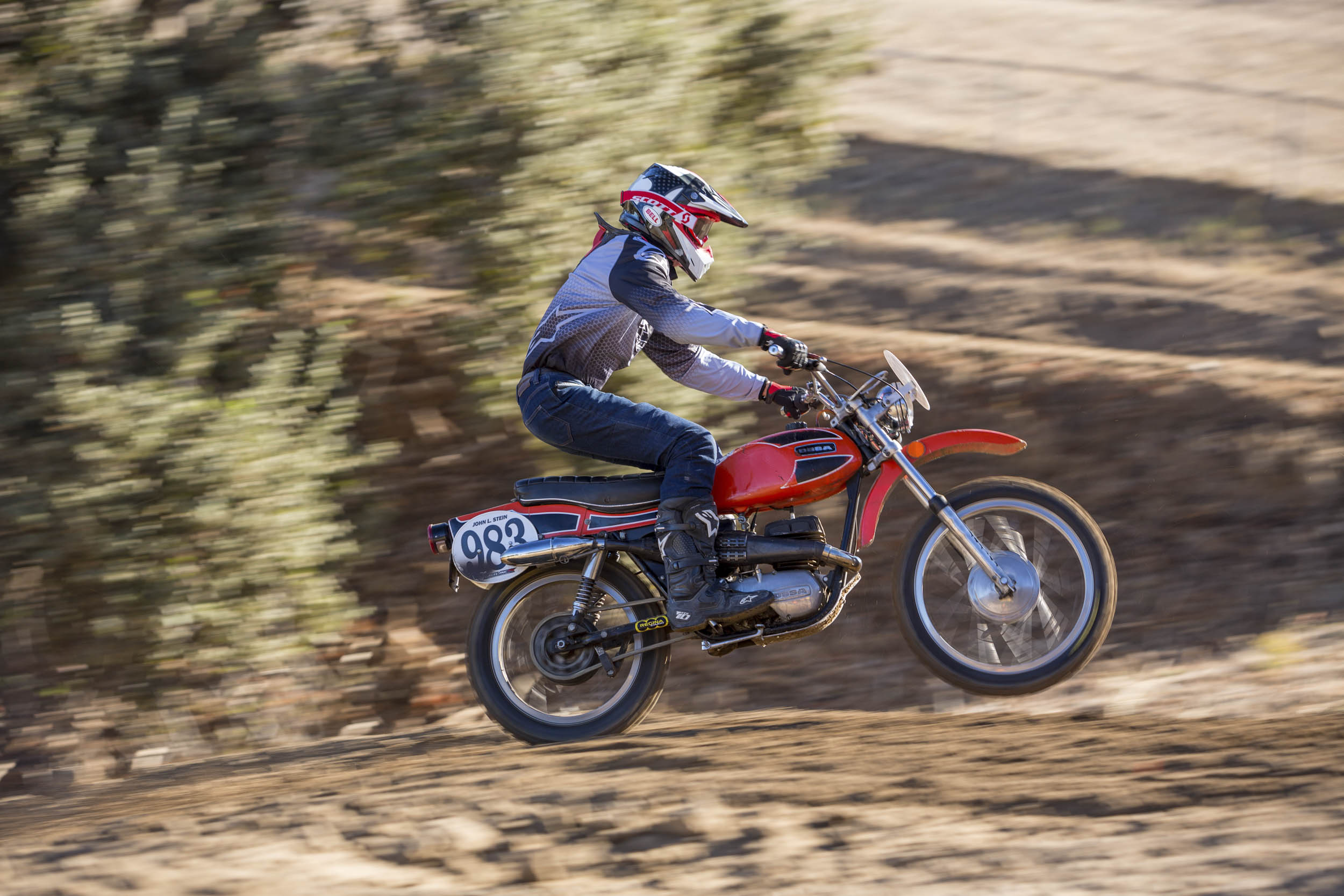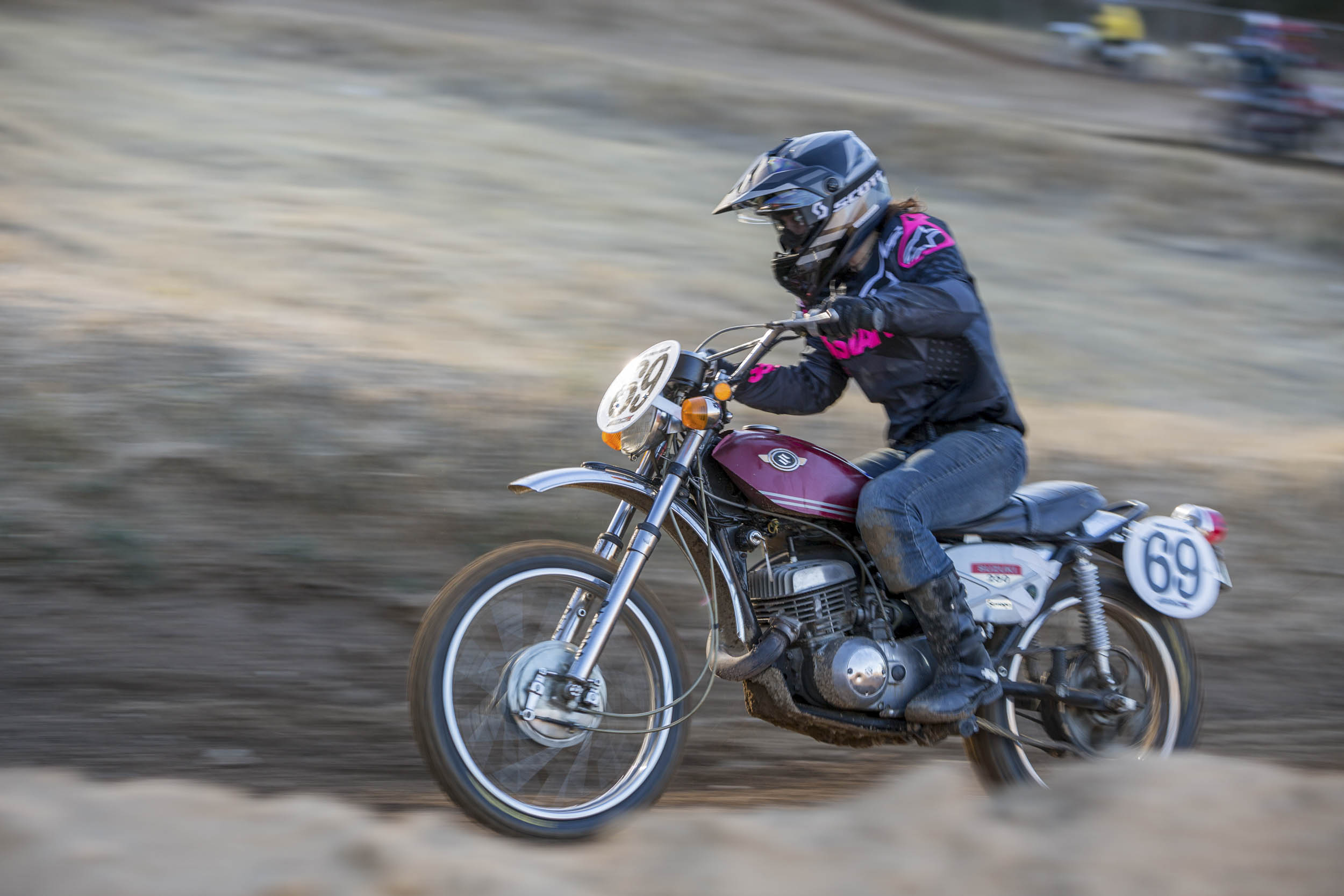Vintage Tour Cross pushes the limits of decades- old dirt bikes
“I’ve been a puppet, a pauper, a pirate, a poet, a pawn, and a king,” Frank Sinatra sang in That’s Life. The same might apply to my motorcycling career, thanks to longtime interest in vintage dirt bikes, street bikes, and road racers, and modern superbikes and motocrossers—even touring. With such eclectic (some might say schizophrenic) tastes, sometimes it’s hard to know what to pursue next. And so, last year I decided to combine three longtime loves—old enduro bikes, touring, and motocross—into one grand three-day adventure. “Vintage Tour Cross” was born.
The plan was simple enough: Three friends, riding a 1969 Suzuki TS250 Savage, 1971 Ossa Pioneer 250 Enduro, and 1975 Honda XL350, would load up our gear and travel 350 miles over two-lane backroads from Santa Barbara to Hollister, California, for the 21st round of the AHRMA Vintage Motocross championship would be held. We’d then camp in the pits and race the vintage national on Sunday. Unprecedented? Yes. Unlikely? Sure. But we wanted to try.
Joining me were 10-time car racing national champion and avid motorcyclist Randy Pobst; his friend Deborah Inskeep, a marine biologist and sport-bike enthusiast; and racing photographer and rock climber Seth DeDoes, who would follow in a Ford F-250 Super Duty pickup carrying his camera gear and gas, oil, and tools. While Probst has some 500 car races to his credit, he had just one motorcycle event under his belt. And Inskeep had never ridden in the dirt. This was indeed going to be a challenge.

The bikes
Randy’s Suzuki was stock and nearly all there, but close inspection uncovered mousy wiring, a horn that intermittently bleated on and off, nonfunctioning turn signals, an inoperative tachometer, a gummed-up carburetor, and worst of all, much piston slap. But it showed just 4100 miles on the odometer, and after a carb rebuild it started, idled, ran, and shifted gears fine.
My beloved Ossa was essentially fit for duty, except for a questionable charging system and the possibility that the Spanish fiberglass tank—coated several years ago with Caswell—would start seeping anew on the long road ride. Even after 46 years, the venerable Pioneer had gone only 2800 miles.
And Deborah’s Honda? Well, it was a Honda. Everything worked, including the lights, fork lock, and turn signals. After cleaning the carburetor, Randy had turned it into a real pussycat. With just 2950 miles on the clock, the XL350 was eager to go.


The bikes’ tires were OK for a road ride, but not for the Hollister motocross. On an MX track, nothing helps more than fresh, square-edged knobbies, so I fitted new Dunlop tires to the two-strokes. With Deborah new to dirt bikes, we carried her Dunlops in the truck to install them upon arrival at Hollister, giving her the security of the Honda’s more street-oriented tires on the two-day tour.
Lubricants were changed to fresh Lucas Oil products, and new Regina drive chains were rolled on. As the piece de resistance, FastLane MX prepared some customized numbers, which I applied to standard 9×11-inch oval plates attached with simple aluminum bracketry. Suddenly, our otherwise standard vintage enduros looked like bona fide ISDT bikes. So cool!
Slow out of the gate
Our planned 8 a.m. departure morphed into 1 p.m. as our group assembled, sorted through riding gear, packed up the chase truck, and bungee-corded sleeping bags and gear onto the bikes. Finally on the road, I felt a surge of emotions: excitement to be underway on a unique trip; anxiety about possible mechanical problems; and worry about being behind schedule. Fortunately, the first leg from Santa Barbara to the mountain town of Ojai was uneventful. So far, so good.

The first real test was climbing Pine Mountain above Ojai, a nearly mile-high summit that tested both power and stamina. All three bikes made it without complaint, but unwelcome circumstances greeted us on the far side as we dropped into the Cuyama Valley. Here the sun set instantly behind the coastal mountains, and the temperature likewise dropped to “shivering.” We gritted and bared it through a photo location that Seth wanted to hit, and then continued. Losing elevation on the far side of the mountains raised the temperature a bit, but it was clearly going to be a long ride to our intended overnight stop in Coalinga, a 202-mile day.
Dusk and deeper cold arrived as our group gamely turned onto Highway 166, heading for the little town of Maricopa. There was zero need for discussion, just quiet resolve. We all knew where we were, how far behind we were, what time it was, how far we had to go, and what the temperature was. And we kept going. This resolve proved that exactly the right people had signed on for the trip.
As darkness arrived, so did the first mechanical problem: A no-go Ossa headlight. Pulling into a truck brake-check area, I dug out a voltmeter, spare fuses, and patch cords, and tracked the circuitry back to the magneto, whose lighting coil was producing no useful electrons. The solution? Two ultra-bright flashlights: a six-cell Maglite up front and a two-cell LED unit (with the Ossa’s taillight lens taped over it) in back. Amazingly, the result nearly equaled the Pioneer’s six-volt OE lighting, and we proceeded northward to Taft, countering the cold by doubling up gloves and tripling up other layers. We completed an abbreviated first day—112 miles—with some hot Mexican food in a wonderfully lumpy, Naugahyde-upholstered booth at a local diner.

A Savage meltdown
Sunup brought a glorious sight: cloudless skies and our three vintage enduro bikes parked side-by-side, two with their Dunlop knobbies freshly broken in, bugs nicely splattered across all three front number plates, and chain lube and exhaust streaks already covering the back ends. After breakfast we refueled, repacked, and remounted for the longest day of our trip—more than 220 miles north to the Hollister Hills State Vehicle Recreation Area, home of the motocross national.
The day started great, riding with our backs to the sun, soaking up the day’s growing warmth, and clicking off the miles. If you like gritty vistas, ride SR 33 north from Taft sometime: Mile after mile of pumping oil derricks, dirt roads, oily pipelines, service trucks, and tumbleweeds—it’s all here, just like a scene from John Wayne’s Hellfighters.
It’s also where real bike trouble found us, as the prolonged high speeds brought the death of the Savage’s top end as the engine slowed, soured, and then lost power altogether. Randy coasted to a stop on a dirt turnout, and Deborah and I circled back. Alarmingly, there the TS250 now had no compression, and the kickstarter turned uselessly as the melted piston slid up and down in the bore. No good.

Tools, we had. Duct tape and wire, we had. Spark plugs, oil, and gas, we had. But we didn’t have a piston kit for a 48-year-old Suzuki. So we ceremoniously loaded the bike into the pickup and carried on.
Arriving in Coalinga around lunchtime, we refueled and then set about calculating a Suzuki fix. What greeted us inside the combustion chamber was beyond disturbing. The entire front of the piston crown was eaten away by detonation. Fixing this would require creativity—and a miracle. With no parts available, the local Ace Hardware yielded a $9 gallon of muriatic acid for dissolving aluminum off the iron bore, and the local auto-parts store produced an adjustable cylinder hone for $34. We were doubtful of the outcome, but we were willing to try. We had to try.
The night shift

I’ll feel forever guilty that “The Rocket”—as Pobst is affectionately called in car-racing circles—had to ride in the truck and missed riding the best part of the trip, SR 198 and 25 from Coalinga to Hollister. Rising and falling, twisting and turning, and flanked by golden fields and grasslands straight out of Steinbeck’s East of Eden, the route is 92 miles of bucolic beauty.
The sun ducked behind Hollister Hills as we finally pulled into the campground, where we found a gypsy park full of like-minded souls, their CZs and Pursangs, BSAs and Greeves stationed like sentries guarding tents, trailers, and trucks. We quickly located a lovely camping spot under a broad oak tree, but there was no time for dinner. Out came the Suzuki and off came its exhaust pipe, carburetor, and cylinder to reveal a worst-case scenario. The cylinder, once a precise 72mm diameter barrel, now carried nasty streaks of aluminum at the exhaust port. The piston was even worse, its crown crumbling, its top ring pinched tight by melted aluminum, and its lower ring literally welded in place.
We swarmed the bike until after 10 p.m., a volunteer from a nearby campsite doing a great job cleaning up the cylinder with the muriatic acid, the chemical reaction bubbling away the aluminum streak. But the piston was a much tougher save, and I spent two hours with a knife, razor blade, wet-and-dry sandpaper, and file, freeing the top ring but then running into a roadblock trying to unstick the lower ring. Ultimately it just got too late, and with the Ossa and Honda needing only minimal attention to race, we called it a day. We’d been at it 14 hours.

One star dies, another is reborn
Woken at dawn by the distant sound of a two-stroke being warmed up, we began one of the most harried motorcycle days imaginable. As a team, we wanted just one thing: For all three bikes to line up and race. However, another surprise awaited as I swapped out the Honda’s dual-sport front tire for the new Dunlop knobby, and prepared to do the same for the rear. The Honda would not start for anyone—no way, no how. Off came the fuel line to check gas flow, which was fine. Out came the spark plug to check for spark. There was none. We checked the switches, the lights, the fuse. Still no spark.
Deducing a bad coil, we borrowed one from the torn-down Suzuki and tried it on the Honda. Still no spark. We tried jumping directly from the battery to the coil. No spark again. Finally, Bobby Weindorf, the curator at the Moto Talbott Museum and a former Honda factory superbike mechanic, offered to troubleshoot the bike. His diagnosis: A bad ignition stator. What had 24 hours before been a mission on track was now a mission in shambles with the two Japanese bikes dismantled in our campground and the Spanish machine running fine. Was this a Mad, Mad, Mad, Mad World or what?

What happened next may seem too incredible to believe, but I swear that it is true. The previous night, a visitor casually mentioned that an early Honda CR250 Elsinore piston directly interchanges with the TS250. On a whim, we relayed this to the officials first thing on race morning, and they made an appeal for either piston in their morning rider briefing. Appreciative of the information and gesture, I thought nothing more of it, and put both the Honda and Suzuki out of mind as I lined up for the first moto on the Ossa. It ran great, and after a race-long battle up from mid-pack, I finished competitivelyin third place. Ecstatic, I returned to the pits, took off my helmet, and spied a small box sitting between the power drill and a loaf of wheat bread. Printed on top were “Wiseco” and “CR250.”
“Where did this come from?” I asked. Randy knew. “A guy named Stan Clayton brought it by. His son James heard the announcement, called home and woke up his wife, and asked her to go to the garage and get it. She drove it to the track, and Stan walked it over. He refused to take any money for it.”


In the box was indeed a new standard piston for an early Elsinore, plus a pair of rings. Would it really fit the Suzuki? I grabbed the cleaned-up cylinder and inserted the piston, and they fit together perfectly. The Suzuki wrist pin fit the piston as well. Suddenly, we had a solution, thanks to the kindness of Santa Clara Riders Unlimited (the event’s host club) and the Clayton family.
The only hiccup was that the Suzuki’s needle bearing was too wide to fit inside the Wiseco piston’s wrist-pin bosses. The next moto was fast approaching, so I grabbed the drill and a grinding wheel, a neighbor fired up his generator, and I clamped the bearing cage with Vice-Grips and had at it. The ad hoc bench grinder narrowed the bearing in shorter order, and with the top end hastily assembled, the Suzuki started in one swing of the kickstarter. And none too soon, as our race was just about to line up.
Finishing is winning

Rolling up to the starting gate alongside Randy was surreal. It was the climax of a trip we had long discussed. And just a half hour before, Randy’s Suzuki was a dirty, road-weary bike with its top end torn off. I looked over and yelled, “I told you I would get you to the gate!” But he wasn’t listening—he was staring straight ahead. The gate dropped, and the renewed Suzuki and Ossa lunged ahead, side by side. In one moment, three days of toil and stress, hundreds of miles of travel, frayed tempers, and problems ceased to be important. Vintage Tour Cross was real!
Señor Rocket, as I like to call him, did a great job on track, riding nearly mistake-free and finishing “Not last!” Afterward, Randy summed up the race: “A wide-eyed rookie, I surveyed the line of hardened veterans. Thrilled, scared, and excited, I suppressed a loud voice in my head saying, ‘What the world are you thinking? This is totally nuts.’ Then the gate dropped and off we went!” The Ossa had another good run, as well, again finishing third for an overall podium in a vintage national.
And then it was Deborah’s turn to walk on fire. Due to the Honda’s ignition demise, we quickly swapped her number plates to the Suzuki, and she rolled to the gate and into battle. Incredibly, having never ridden in the dirt, she sparred with two other riders before falling while attempting a pass. She finished after remounting, covered in mud and wearing a huge grin. “I didn’t know what was going to happen, but I never thought I couldn’t do it,” she said later. “So when the gate dropped I went for it.”




A psychologist friend of mine once mused, “Life is sloppy.” He was right, of course, but he couldn’t have known just how well those three words would suit our crazy, brazen Vintage Tour Cross experiment. Yes, it was sloppy. It was also stressful and exhilarating, beautiful and harmonious, challenging and frustrating, mesmerizing and magical, and in the end, euphoric. But at its core, it was also simple: Three vintage bikes, loaded with gear. Three friends, ready to ride. A long, open road upon which to chase a dream. And then finally, a racetrack showdown. All with no guarantees.
In hindsight, despite all the challenges, the first-ever Vintage Tour Cross turned out almost perfect. My takeaway? When you have a dream, resist overthinking it, or you may never go—or ever truly live.













